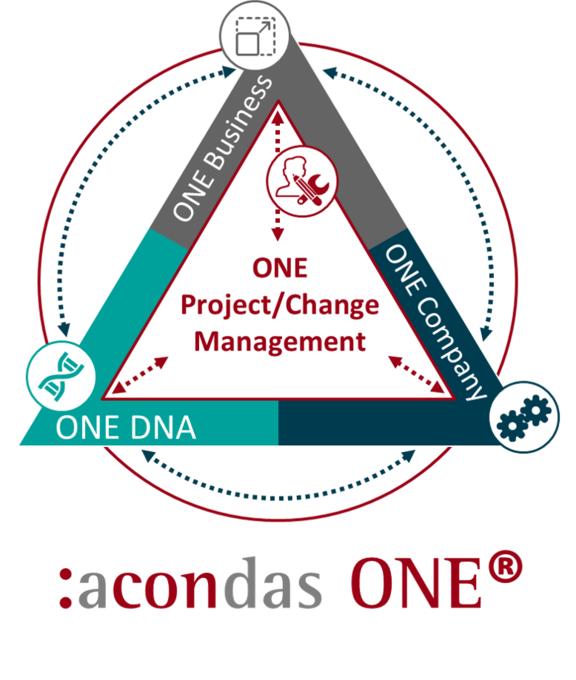Four building blocks of PMI success
Many mergers fail because business models or corporate cultures are incompatible, because the conversion conflicts with day-to-day business or because the complexity is underestimated. But with the right implementation approach, even difficult integration projects can succeed.
The relevant studies are widely known and dramatic individual cases underscore their results: Almost two-thirds of all mergers fail or do not bring nearly the intended effects. A prime example of a bursting fusion dream is the merger of the Internet service provider AOL with the media group Time Warner. The merger that was supposed to connect old and new media worlds failed. Eight years later, 300 billion dollars in stock market value had been destroyed and Time Warner pulled the emergency brake.
Daimler’s merger with Chrysler, announced in 1998 by Daimler CEO Jürgen Schrempp as the “wedding made in heaven”, ended as a mundane financial catastrophe: The failed attempt to bring together two ultimately vastly different corporate cultures cost shareholders at least 40 billion euros. The mergers of the automakers BMW and Rover and the sporting goods manufacturer adidas and Salomon were also initially disastrous and ended in divorce.
But what goes wrong with what is meant to be a big deal?
There are several factors of successful larger integration projects which are often given insufficient attention. First and foremost, expectations on the new business model in the merged company must be formulated early and, above all, realistically. It must also be ensured that day-to-day business functions smoothly despite parallel integration work. To avoid disruptive clashes between different cultures, a joint corporate DNA should be agreed on at an early stage. In addition, enough human resources must be available and dedicated to the integration so that the overall project does not fail due to the complexity of the tasks.
To help companies undertaking integration projects address these factors systematically and cooperatively, acondas has developed the integration approach we call acondas ONE®. This comprehensive kit containing four elements helps clients successfully manage the latent fusion risks in the implementation phase. The core idea of acondas ONE® is that everyone must pull in the same direction. Rather than coexisting, in the worst case chaotically, cooperating leads to success. However, what sounds theoretically comparatively simple can, in practice, be quite demanding.

Both companies have to agree on a common vision and strategy for future development, and thus on a common business model, well in advance of the Day 1 integration deadline. We refer to this as “ONE Business”. If the buyer continues to juxtapose previous business models, only a small share of potential synergy will be realized. In most cases, a buyer’s attempt to impose a previous business model one-to-one on the acquired company will elicit a defensive reaction by the acquired organization and ignore the often subtle peculiarities of both businesses. Synergies can never be fully realized if they are arranged “per-ordre-de-mufti”, i.e. top down. Rather, a new common business model must be agreed on early, too, paving the way for developing a common design of efficient processes, a powerful organization and a shared corporate culture, and, thus, real added value. To ensure efficient implementation of the new business model, all individual measures must also be identified with realistic sub-goals, supported by everyone affected, and tracked continuously.
The same applies to the corporate culture. Formulating a common DNA for the future is a mammoth task (“ONE DNA”), especially for cross-border mergers. The participants should agree on the desired cornerstones of the future common understanding of culture before the contracts are signed, as experience shows, even during the due diligence phase.
Often, the uncertainty in the workforce is overlooked, resulting in resistance. Such problems can be overcome most easily if the basic values of both partners are also reflected in the future common culture. Therefore, cultural integration also requires a systematic implementation concept, which must be communicated to the workforces of both companies. Only in this way can those affected become responsible participants in cultural change.
The first step in developing a common catalog of values is to have a deep understanding of one’s own and each other’s corporate culture and to recognize similarities and differences. But how can this be organized practically? Surely not with surveys and analysis, but only in exchange with each other – during the due diligence phase, in preparation for “Day 1”, and especially in the first weeks of growing together. Unfortunately, in many integration projects the exchange is limited to commercial and technical issues. In our experience, much more attention must be paid to the human component: How do the employees think, work and feel “on the other side”?
Above all, successful integrations entail integrating all individual steps and measures. In order for the integration of business models and organizations to go hand in hand, joint management structures and processes are required (“ONE Company”). These must be determined early so that a smooth transition to the future organizational model is guaranteed by the integration date.
Last but not least, it requires a master plan that brings together all the individual steps and elements in terms of organization and time, and that is backed up with sufficient resources. For the integration concept, the planning and control, a joint project and change management is required from a single source, so that all tasks can be processed cleanly on Day 1 and beyond. This ensures that the desired changes are understood and accepted by all employees.
Any major integration is a time-consuming effort that often takes years to complete in addition to day-to-day business and requires specialist, methodological, and social skills. The acondas ONE® approach structures integration projects in each phase so that all essential success factors can be planned and controlled in unison. A large number of successfully supported projects prove the effectiveness of this approach.
If you have any questions about the acondas ONE® approach or our expertise in integration projects, feel free to contact us at info@acondas.com.
